Uri Shaham
ECLeKTic: a Novel Challenge Set for Evaluation of Cross-Lingual Knowledge Transfer
Feb 28, 2025Abstract:To achieve equitable performance across languages, multilingual large language models (LLMs) must be able to abstract knowledge beyond the language in which it was acquired. However, the current literature lacks reliable ways to measure LLMs' capability of cross-lingual knowledge transfer. To that end, we present ECLeKTic, a multilingual closed-book QA (CBQA) dataset that Evaluates Cross-Lingual Knowledge Transfer in a simple, black-box manner. We detected information with uneven coverage across languages by controlling for presence and absence of Wikipedia articles in 12 languages. We generated knowledge-seeking questions in a source language, for which the answer appears in a relevant Wikipedia article and translated them to all other 11 languages, for which the respective Wikipedias lack equivalent articles. Assuming that Wikipedia reflects the prominent knowledge in the LLM's training data, to solve ECLeKTic's CBQA task the model is required to transfer knowledge between languages. Experimenting with 8 LLMs, we show that SOTA models struggle to effectively share knowledge across, languages even if they can predict the answer well for queries in the same language the knowledge was acquired in.
Generalizable Spectral Embedding with an Application to UMAP
Jan 20, 2025Abstract:Spectral Embedding (SE) is a popular method for dimensionality reduction, applicable across diverse domains. Nevertheless, its current implementations face three prominent drawbacks which curtail its broader applicability: generalizability (i.e., out-of-sample extension), scalability, and eigenvectors separation. In this paper, we introduce GrEASE: Generalizable and Efficient Approximate Spectral Embedding, a novel deep-learning approach designed to address these limitations. GrEASE incorporates an efficient post-processing step to achieve eigenvectors separation, while ensuring both generalizability and scalability, allowing for the computation of the Laplacian's eigenvectors on unseen data. This method expands the applicability of SE to a wider range of tasks and can enhance its performance in existing applications. We empirically demonstrate GrEASE's ability to consistently approximate and generalize SE, while ensuring scalability. Additionally, we show how GrEASE can be leveraged to enhance existing methods. Specifically, we focus on UMAP, a leading visualization technique, and introduce NUMAP, a generalizable version of UMAP powered by GrEASE. Our codes are publicly available.
SpecRaGE: Robust and Generalizable Multi-view Spectral Representation Learning
Nov 04, 2024Abstract:Multi-view representation learning (MvRL) has garnered substantial attention in recent years, driven by the increasing demand for applications that can effectively process and analyze data from multiple sources. In this context, graph Laplacian-based MvRL methods have demonstrated remarkable success in representing multi-view data. However, these methods often struggle with generalization to new data and face challenges with scalability. Moreover, in many practical scenarios, multi-view data is contaminated by noise or outliers. In such cases, modern deep-learning-based MvRL approaches that rely on alignment or contrastive objectives can lead to misleading results, as they may impose incorrect consistency between clear and corrupted data sources. We introduce $\textit{SpecRaGE}$, a novel fusion-based framework that integrates the strengths of graph Laplacian methods with the power of deep learning to overcome these challenges. SpecRage uses neural networks to learn parametric mapping that approximates a joint diagonalization of graph Laplacians. This solution bypasses the need for alignment while enabling generalizable and scalable learning of informative and meaningful representations. Moreover, it incorporates a meta-learning fusion module that dynamically adapts to data quality, ensuring robustness against outliers and noisy views. Our extensive experiments demonstrate that SpecRaGE outperforms state-of-the-art methods, particularly in scenarios with data contamination, paving the way for more reliable and efficient multi-view learning. Our code will be made publicly available upon acceptance.
G-SPARC: SPectral ARchitectures tackling the Cold-start problem in Graph learning
Nov 03, 2024



Abstract:Graphs play a central role in modeling complex relationships across various domains. Most graph learning methods rely heavily on neighborhood information, raising the question of how to handle cold-start nodes - nodes with no known connections within the graph. These models often overlook the cold-start nodes, making them ineffective for real-world scenarios. To tackle this, we propose G-SPARC, a novel framework addressing cold-start nodes, that leverages generalizable spectral embedding. This framework enables extension to state-of-the-art methods making them suitable for practical applications. By utilizing a key idea of transitioning from graph representation to spectral representation, our approach is generalizable to cold-start nodes, capturing the global structure of the graph without relying on adjacency data. Experimental results demonstrate that our method outperforms existing models on cold-start nodes across various tasks like node classification, node clustering, and link prediction. G-SPARC provides a breakthrough built-in solution to the cold-start problem in graph learning. Our code will be publicly available upon acceptance.
CoverBench: A Challenging Benchmark for Complex Claim Verification
Aug 06, 2024Abstract:There is a growing line of research on verifying the correctness of language models' outputs. At the same time, LMs are being used to tackle complex queries that require reasoning. We introduce CoverBench, a challenging benchmark focused on verifying LM outputs in complex reasoning settings. Datasets that can be used for this purpose are often designed for other complex reasoning tasks (e.g., QA) targeting specific use-cases (e.g., financial tables), requiring transformations, negative sampling and selection of hard examples to collect such a benchmark. CoverBench provides a diversified evaluation for complex claim verification in a variety of domains, types of reasoning, relatively long inputs, and a variety of standardizations, such as multiple representations for tables where available, and a consistent schema. We manually vet the data for quality to ensure low levels of label noise. Finally, we report a variety of competitive baseline results to show CoverBench is challenging and has very significant headroom. The data is available at https://huggingface.co/datasets/google/coverbench .
Sparse Binarization for Fast Keyword Spotting
Jun 09, 2024



Abstract:With the increasing prevalence of voice-activated devices and applications, keyword spotting (KWS) models enable users to interact with technology hands-free, enhancing convenience and accessibility in various contexts. Deploying KWS models on edge devices, such as smartphones and embedded systems, offers significant benefits for real-time applications, privacy, and bandwidth efficiency. However, these devices often possess limited computational power and memory. This necessitates optimizing neural network models for efficiency without significantly compromising their accuracy. To address these challenges, we propose a novel keyword-spotting model based on sparse input representation followed by a linear classifier. The model is four times faster than the previous state-of-the-art edge device-compatible model with better accuracy. We show that our method is also more robust in noisy environments while being fast. Our code is available at: https://github.com/jsvir/sparknet.
Multilingual Instruction Tuning With Just a Pinch of Multilinguality
Jan 08, 2024Abstract:As instruction-tuned large language models (LLMs) gain global adoption, their ability to follow instructions in multiple languages becomes increasingly crucial. One promising approach is cross-lingual transfer, where a model acquires specific functionality on some language by finetuning on another language. In this work, we investigate how multilinguality during instruction tuning of a multilingual LLM affects instruction-following across languages. We first show that many languages transfer some instruction-following capabilities to other languages from even monolingual tuning. Furthermore, we find that only 40 multilingual examples in an English tuning set substantially improve multilingual instruction-following, both in seen and unseen languages during tuning. In general, we observe that models tuned on multilingual mixtures exhibit comparable or superior performance in several languages compared to monolingually tuned models, despite training on 10x fewer examples in those languages. Finally, we find that increasing the number of languages in the instruction tuning set from 1 to only 2, 3, or 4 increases cross-lingual generalization. Our results suggest that building massively multilingual instruction-tuned models can be done with only a very small set of multilingual instruction-responses.
ZeroSCROLLS: A Zero-Shot Benchmark for Long Text Understanding
May 23, 2023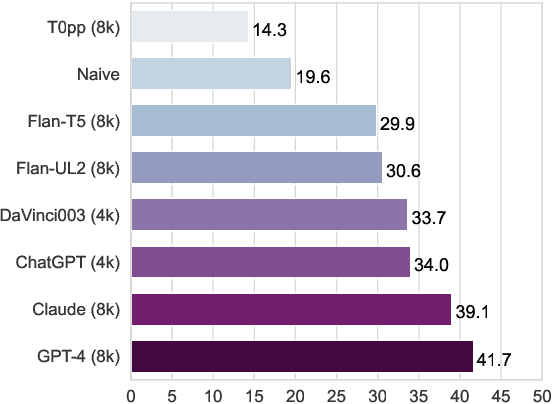

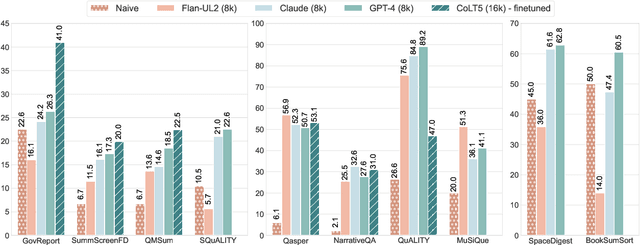
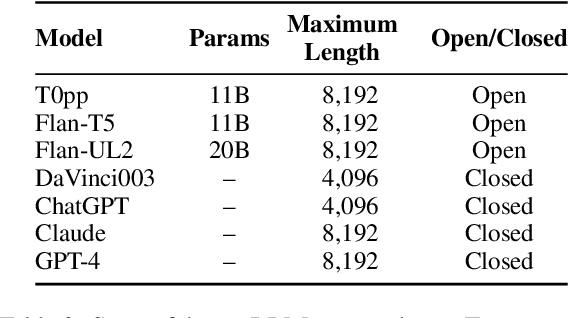
Abstract:We introduce ZeroSCROLLS, a zero-shot benchmark for natural language understanding over long texts, which contains only test sets, without training or development data. We adapt six tasks from the SCROLLS benchmark, and add four new datasets, including two novel information fusing tasks, such as aggregating the percentage of positive reviews. Using ZeroSCROLLS, we conduct a comprehensive evaluation of both open-source and closed large language models, finding that Claude outperforms ChatGPT, and that GPT-4 achieves the highest average score. However, there is still room for improvement on multiple open challenges in ZeroSCROLLS, such as aggregation tasks, where models struggle to pass the naive baseline. As the state of the art is a moving target, we invite researchers to evaluate their ideas on the live ZeroSCROLLS leaderboard
Causes and Cures for Interference in Multilingual Translation
Dec 14, 2022Abstract:Multilingual machine translation models can benefit from synergy between different language pairs, but also suffer from interference. While there is a growing number of sophisticated methods that aim to eliminate interference, our understanding of interference as a phenomenon is still limited. This work identifies the main factors that contribute to interference in multilingual machine translation. Through systematic experimentation, we find that interference (or synergy) are primarily determined by model size, data size, and the proportion of each language pair within the total dataset. We observe that substantial interference occurs mainly when the model is very small with respect to the available training data, and that using standard transformer configurations with less than one billion parameters largely alleviates interference and promotes synergy. Moreover, we show that tuning the sampling temperature to control the proportion of each language pair in the data is key to balancing the amount of interference between low and high resource language pairs effectively, and can lead to superior performance overall.
Efficient Long-Text Understanding with Short-Text Models
Aug 01, 2022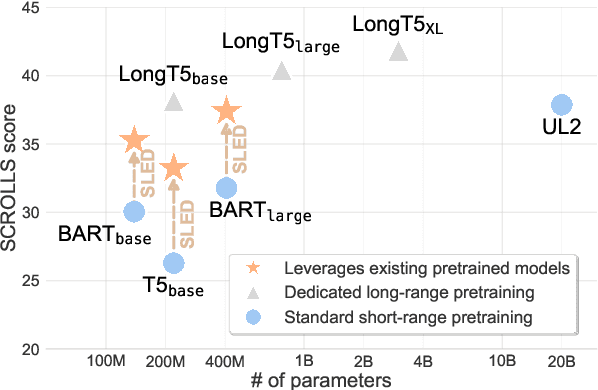
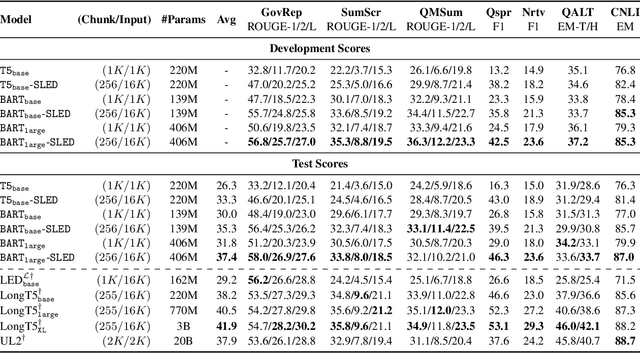

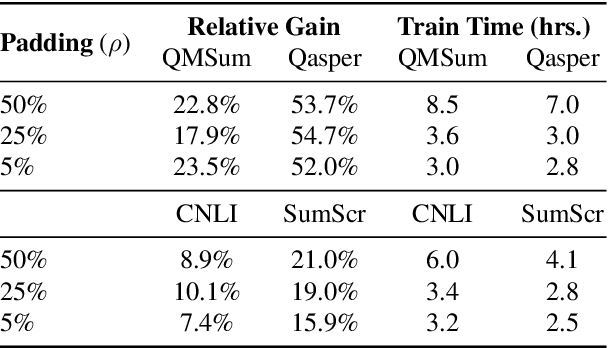
Abstract:Transformer-based pretrained language models (LMs) are ubiquitous across natural language understanding, but cannot be applied to long sequences such as stories, scientific articles and long documents, due to their quadratic complexity. While a myriad of efficient transformer variants have been proposed, they are typically based on custom implementations that require expensive pretraining from scratch. In this work, we propose SLED: SLiding-Encoder and Decoder, a simple approach for processing long sequences that re-uses and leverages battle-tested short-text pretrained LMs. Specifically, we partition the input into overlapping chunks, encode each with a short-text LM encoder and use the pretrained decoder to fuse information across chunks (fusion-in-decoder). We illustrate through controlled experiments that SLED offers a viable strategy for long text understanding and evaluate our approach on SCROLLS, a benchmark with seven datasets across a wide range of language understanding tasks. We find that SLED is competitive with specialized models that are up to 50x larger and require a dedicated and expensive pretraining step.
 Add to Chrome
Add to Chrome Add to Firefox
Add to Firefox Add to Edge
Add to Edge